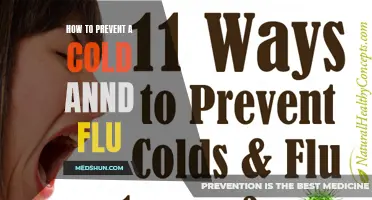
The flu and common cold are two illnesses that we often associate with the colder months of the year. Despite their similar symptoms, these two maladies are actually caused by different types of pathogens – the flu is caused by the influenza virus, while colds are caused by various types of viruses. In this article, we will delve into the differences between these two ailments, exploring their causes, symptoms, and methods of prevention. So, whether you find yourself reaching for a tissue or feeling achy and feverish, read on to learn more about the microscopic organisms behind the flu and colds.
| Characteristics | Values |
|---|---|
| Type | Bacteria / Virus |
| Cause | Influenza viruses / Rhinoviruses |
| Transmission | Respiratory droplets, contact with infected surfaces |
| Symptoms | Fever, cough, sore throat, runny or stuffy nose, muscle or body aches |
| Duration | Flu: 1-2 weeks; Colds: 1-2 weeks |
| Severity | Flu: can be severe; Colds: mild |
| Complications | Pneumonia, bronchitis, sinus infections, ear infections |
| Treatment | Rest, fluids, over-the-counter medication, antiviral medication |
| Prevention | Annual flu vaccine, hand hygiene, avoiding close contact with sick individuals |
What You'll Learn

Understanding the Difference: Bacteria vs. Viruses in Flu and Colds
When it comes to flu and colds, many people wonder whether they are caused by bacteria or viruses. Understanding the difference between these two types of microorganisms can help in prevention, treatment, and management of these illnesses. In this article, we will explore the characteristics of bacteria and viruses and their role in causing flu and colds.
Bacteria are single-celled organisms that can be found everywhere, from the air we breathe to the surfaces we touch. They come in different shapes and sizes, and while some bacteria are beneficial and necessary for our health, others can cause infections. Bacterial infections can affect various body parts, including the respiratory system, leading to symptoms like a sore throat, cough, and fever.
On the other hand, viruses are smaller than bacteria and can only survive and multiply inside living cells. Unlike bacteria, viruses lack the cellular machinery to reproduce on their own. Instead, they hijack the machinery of host cells to replicate. Viral infections can also affect the respiratory system, causing symptoms similar to those of bacterial infections.
So, are flu and colds caused by bacteria or viruses? The answer is viruses. Influenza, commonly known as the flu, is caused by the influenza virus, while the common cold is primarily caused by different types of viruses, such as rhinoviruses. These viruses enter the body through the nose, mouth, or eyes, and can be spread from person to person through respiratory droplets or by touching contaminated surfaces.
Understanding that flu and colds are caused by viruses is essential because it affects how we approach prevention and treatment. Antibiotics, which are commonly prescribed for bacterial infections, are ineffective against viral infections. Taking antibiotics unnecessarily can lead to antibiotic resistance and other complications.
Preventing the spread of flu and colds involves adopting good hygiene practices, such as washing hands frequently with soap and water, avoiding close contact with sick individuals, and covering the mouth and nose when coughing or sneezing. Additionally, getting vaccinated against the flu can help reduce the risk of infection and its complications.
When it comes to treatment, antiviral medications may be prescribed for severe cases of the flu. These medications work by preventing the virus from replicating, thus reducing the severity and duration of symptoms. For colds, over-the-counter medications can help relieve symptoms, but rest, fluids, and good self-care are often the best approach.
In summary, understanding the difference between bacteria and viruses is crucial in managing flu and colds. While bacteria are single-celled organisms that can cause infections, flu and colds are primarily caused by viruses. Taking appropriate preventive measures, such as good hygiene practices and vaccination, can help reduce the risk of infection. Additionally, understanding that antibiotics are ineffective against viral infections can prevent unnecessary use and complications. If you're unsure about the cause of your illness or if symptoms worsen, it is always best to consult a healthcare professional for an accurate diagnosis and appropriate treatment.
Effective Ways to Get Rid of Colds and Ease Cold Symptoms
You may want to see also

Symptoms and Transmission of the Flu and Colds Bacteria and Viruses
Flu and colds are both viral infections rather than bacterial ones. Although they share some similarities in terms of symptoms, there are distinct differences between the two.
The flu, also known as influenza, is caused by the influenza virus. There are three main types of the influenza virus: A, B, and C. Influenza A and B are the most common types that cause seasonal flu outbreaks. Influenza C is less common and usually causes milder symptoms.
The common cold, on the other hand, is caused by a group of viruses known as rhinoviruses. There are over 200 types of viruses that can cause the common cold, with rhinoviruses being the most prevalent.
Symptoms of the flu and colds can often be similar, but there are some differences. The flu typically causes more severe symptoms, including high fever, body aches, fatigue, and a dry cough. Colds, on the other hand, usually cause milder symptoms such as a runny or stuffy nose, sore throat, and mild cough. It's important to note that these symptoms can vary from person to person, and some individuals may experience more severe symptoms with a cold or milder symptoms with the flu.
Transmission of the flu and colds occurs through respiratory droplets that are expelled when an infected person coughs, sneezes, or talks. These droplets can then be inhaled by others nearby, leading to infection. Touching surfaces contaminated by respiratory droplets and then touching the face can also result in transmission of the viruses.
Preventing the transmission of the flu and colds can be done by taking several precautionary measures. First and foremost, practicing good hand hygiene is essential. Regularly washing hands with soap and water for at least 20 seconds or using an alcohol-based hand sanitizer can help kill any viruses present on the hands. Avoiding close contact with individuals who are sick and covering the mouth and nose when coughing or sneezing can also prevent the spread of viruses.
In terms of treatment, there is no cure for the flu or colds caused by viruses. Both infections are typically self-limiting and resolve on their own with time. However, there are medications available to help alleviate symptoms and make the individual more comfortable. Antiviral drugs can be prescribed for the treatment of the flu, but they need to be taken within a certain time frame after the onset of symptoms to be effective. Over-the-counter medications such as pain relievers, decongestants, cough suppressants, and antihistamines can help relieve symptoms associated with both the flu and colds.
In conclusion, the flu and colds are viral infections caused by different types of viruses. While they share some similarities in symptoms, the flu tends to cause more severe symptoms compared to the common cold. Proper hand hygiene, avoiding close contact with sick individuals, and practicing respiratory etiquette are important measures in preventing the transmission of these viruses. If symptoms become severe or persistent, it is recommended to seek medical attention.
Understanding the Latest Strain of Flu Circulating: What You Need to Know
You may want to see also

Treating Bacterial and Viral Infections of the Flu and Colds
As winter sets in, flu and cold season comes along with it. These common illnesses can make us feel miserable, with symptoms like coughing, sneezing, congestion, and body aches. But have you ever wondered whether flu and colds are caused by bacteria or viruses? And more importantly, how can we effectively treat them?
The flu and colds are caused by viruses, not bacteria. Influenza, or simply the flu, is caused by the influenza virus. The common cold, on the other hand, can be caused by various types of viruses, such as rhinoviruses, coronaviruses, and respiratory syncytial virus (RSV).
Since flu and colds are caused by viruses, antibiotics are ineffective in treating them. Antibiotics are designed to kill bacteria, not viruses. Therefore, it is crucial to understand that taking antibiotics to treat the flu or colds will not help. In fact, it may even lead to antibiotic resistance, making it harder to treat bacterial infections in the future.
So, if antibiotics are not the solution, what can we do to treat bacterial and viral infections associated with the flu and colds? The first step is to focus on relieving the symptoms and allowing our bodies to fight off the infections naturally. Here are some effective strategies:
- Rest and take care of yourself: Make sure to get plenty of rest to help your immune system function at its best. Take time off work or school if needed, and give your body the time it needs to recover.
- Stay hydrated: Drink plenty of fluids such as water, herbal tea, and clear broths. Staying hydrated helps keep your respiratory system functioning properly and prevents dehydration, which can worsen symptoms.
- Use over-the-counter medications: Over-the-counter cold and flu medications can help relieve symptoms such as congestion, cough, and fever. Be sure to carefully follow the dosage instructions and consult with a healthcare professional if you have any underlying medical conditions or if you are taking other medications.
- Use saline nasal sprays or rinses: Saline solutions can help relieve nasal congestion and moisturize the nasal passages. They are available over the counter and can be used multiple times a day for relief.
- Use cough drops or lozenges: Sucking on cough drops or lozenges can help soothe a sore throat and temporarily relieve cough symptoms.
- Practice good hygiene: Wash your hands frequently with soap and water or use hand sanitizer to prevent the spread of viruses. Cover your mouth and nose with a tissue or the crook of your elbow when you cough or sneeze to prevent the spread of germs.
If your symptoms worsen or persist for more than a week, it is important to seek medical attention. In some cases, complications can arise from the flu or colds, such as sinus infections or pneumonia. A healthcare professional can evaluate your condition and determine if further treatment is necessary.
In conclusion, flu and colds are caused by viruses, not bacteria. Therefore, antibiotics are not effective in treating them. Instead, focus on relieving symptoms and supporting your body's natural immune response. By taking care of yourself, staying hydrated, using over-the-counter medications when necessary, practicing good hygiene, and seeking medical attention when needed, you can effectively manage bacterial and viral infections associated with the flu and colds.
Exploring the Possibility: Can You Get Sick Twice?
You may want to see also

Prevention Strategies for Bacterial and Viral Flu and Colds Infections
Flu and colds are common respiratory illnesses that many of us experience at some point in our lives. While they may seem similar, there are some key differences between the two. One of the main differences lies in their causes – flu is caused by the influenza virus, while colds can be caused by several different types of viruses. However, bacterial infections can also sometimes lead to flu-like symptoms.
Understanding the difference between bacterial and viral infections is important because it can help guide our prevention strategies. Bacterial infections are caused by bacteria, which are single-celled microorganisms. Viral infections, on the other hand, are caused by viruses, which are much smaller than bacteria.
When it comes to prevention, there are some general strategies that can help protect against both bacterial and viral flu and colds infections:
- Practice good hygiene: One of the most effective ways to prevent the spread of bacterial and viral infections is to practice good hygiene. This includes washing your hands regularly with soap and water for at least 20 seconds, or using hand sanitizer if soap and water are not available. Avoid touching your face, especially your eyes, nose, and mouth, as these are common entry points for bacteria and viruses. Also, cover your mouth and nose with a tissue or your elbow when you cough or sneeze, and dispose of the tissue properly.
- Get vaccinated: Vaccination is a crucial step in preventing flu infections. There are flu vaccines available each year that are designed to protect against the most common strains of the influenza virus. It's important to get vaccinated annually, as the flu virus can change and new strains can emerge. While there is no vaccine for the common cold, getting the flu vaccine can reduce the risk of developing severe symptoms that could be mistaken for a cold.
- Boost your immune system: A healthy immune system is better equipped to fight off bacterial and viral infections. Make sure to eat a balanced diet rich in fruits, vegetables, and whole grains, which provide essential vitamins and minerals. Get regular exercise to improve blood circulation and boost immune function. Also, get enough sleep each night, as sleep deprivation can weaken the immune system.
- Avoid close contact with sick individuals: Bacterial and viral infections can easily spread through close contact. If someone in your household or workplace is sick, try to keep a safe distance from them to minimize the risk of transmission. Avoid sharing personal items like utensils, towels, and cups to prevent the spread of bacteria and viruses.
- Clean and disinfect frequently-touched surfaces: Bacteria and viruses can survive on surfaces for hours or even days. Cleaning and disinfecting frequently-touched surfaces, such as doorknobs, light switches, and countertops, can help kill bacteria and viruses and prevent their spread.
- Stay home when you're sick: If you're feeling unwell with flu-like symptoms, it's important to stay home and rest. Going to work or school when you're sick can increase the risk of spreading the infection to others.
It's important to note that while prevention strategies can reduce the risk of bacterial and viral flu and colds infections, they do not guarantee complete immunity. It's still possible to get infected despite taking precautions. However, by following these strategies, you can significantly lower your risk and promote overall health and well-being.
The Peak Periods of Cold Contagion: Understanding When a Cold is Most Infectious
You may want to see also
Frequently asked questions
Both flu and colds are caused by viruses, not bacteria. The influenza virus causes the flu, while the rhinovirus is the most common cause of the common cold.
Since there is no cure for viral infections, the flu and colds are primarily treated with rest, fluids, and over-the-counter medications to relieve symptoms. In some cases, antiviral medications may be prescribed for the flu to help reduce the severity and duration of symptoms.
No, antibiotics are only effective against bacterial infections, not viral infections. Taking antibiotics unnecessarily can lead to antibiotic resistance and other health complications. It is important to consult a healthcare professional for proper diagnosis and treatment guidance.







